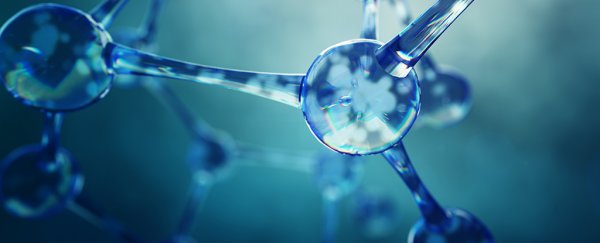A two-step cooling process using lasers has allowed physicists to push molecules of calcium monofluoride down to a record low temperature, busting a barrier that until now has been impassable.
Decades ago, chilling individual atoms to near absolute zero opened a new world of research for particle physicists. This latest breakthrough could also provide fertile ground for learning more on how atoms behave when bound together as molecules.
The process behind the record cooling performed by researchers from The Centre for Cold Matter at Imperial College London isn't all that different to those used to cool atoms.
A moving particle is a hot particle, meaning to cool down either an atom or a molecule you simply need to slow down its buzzing.
One way to do this is to take advantage of how atoms absorb and emit quanta of light, potentially losing some momentum in the process.
A laser tuned to a particular frequency is aimed at atoms trapped in a confined space by a magnetic field.
If the atom is moving away from the light, the frequency it experiences is Doppler shifted slightly towards the red end of the spectrum. If the particle is moving into the beam, the frequency hitting it shifts towards the blue end.
Getting that frequency right means atoms moving into the laser at a given velocity can absorb a photon of light. This bumps up one of its electrons to a new energy level, which then emits a photon in a random direction when it comes down.
Spread out over the particles, this emission of photons means an overall decrease in momentum for the atoms, gradually slowing them down.
This process called Doppler cooling can only get particles so cold, as the energy lost by emitting photons is balanced by the energy the atoms receive in the trap.
Individual atoms can be cooled beyond this so-called Doppler limit with various other techniques, allowing physicists to reach mind-blowing temperatures of just 50 trillionths of a kelvin, or 0.00000000005 degrees above absolute zero.
But until now physicists have only managed to force atoms into making molecules while cold, or cool existing molecules of strontium fluoride to temperatures above the Doppler limit.
Bound together into more complex systems, atoms just don't respond as reliably to the same cooling tricks.
To push the boundaries, researchers held a bunch of calcium monofluoride molecules in place by a combination of magnetic fields and lasers called a magneto-optical trap.
This was enough to take them down to the Doppler limit. To get them over the line, the researchers used a second technique called Sisyphus cooling.
If you remember your Greek myths, King Sisyphus was the doomed soul who was forced to eternally push a boulder up a mountain only for it to roll down the other side, all because he was the kind of ruler who liked to murder his guests.
This infinite work-out routine is just the kind of thing to sap particles of their energy.
Instead of a mountain, physicists use a pair of opposing lasers polarised in such a way to force a particle up an energy hill, losing momentum in the process.
This allowed the researchers to drag the calcium monofluoride down to temperatures of 50 microkelvin, or 50 millionths of a degree above absolute zero.
That's still a far cry from how cold we can make individual atoms, but it's better than the previous record of 400 microkelvin accomplished with strontium fluoride molecules.
The theoretical temperature wall of absolute zero is like a Zeno's paradox of particle physics – we can only ever cut a fraction of the energy from a moving particle, making it a mathematical impossibility that a particle could ever have no heat.
But stretching towards that infinite goal has allowed us to study particles in unprecedented detail, displaying strange new behaviours and allowing us to study how forces holding them together arise in the first place.
No doubt this new limit will help expand our knowledge on how chemistry works at a fundamental level.
This research was published in Nature Physics.
